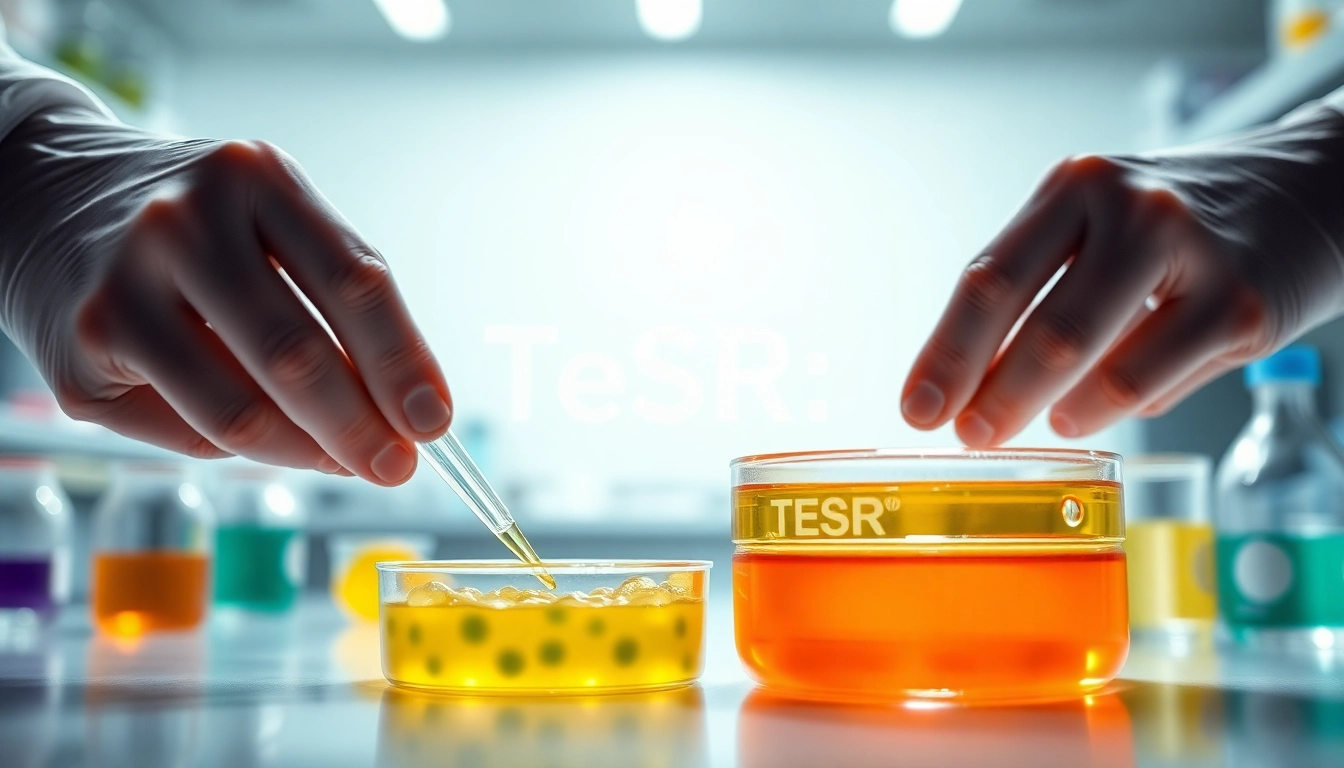Understanding TeSR™ Culture Media
The realm of pluripotent stem cell (PSC) research has evolved significantly over the past two decades, largely facilitated by advanced culture media such as TeSR™. This family of feeder-free media supports scientists in maintaining human embryonic stem (ES) cells and induced pluripotent stem (iPS) cells, aiding in their reprogramming, maintenance, and differentiation. With products like mTeSR™ and TeSR™-AOF, researchers are empowered to pursue groundbreaking studies with greater consistency and ease. For a comprehensive understanding of these innovative media types, researchers can explore all check about TeSR™ products and their applications.
What is Feeder-Free Stem Cell Culture?
Feeder-free stem cell culture refers to a method of growing stem cells without the use of animal-derived feeder layers. Traditionally, PSCs were maintained on fibroblast feeder layers which provided essential growth factors and a suitable microenvironment. However, these methods often led to variability and contamination risks. Feeder-free cultures utilize specially formulated media, such as the TeSR™ family, that provide the necessary nutrients and growth factors in a defined environment. This innovation enhances reproducibility and supports more streamlined workflows in stem cell research.
Key Components of TeSR™ Media
The formulation of TeSR™ media is pivotal to its effectiveness in maintaining PSC cultures. Key components typically include:
- Basal Media: Provides fundamental nutrients required for cell metabolism.
- Cytokines: Critical growth factors such as FGF2 ensure the maintenance of pluripotency and prevent differentiation.
- Specialized Supplements: These might include proprietary blends tailored to enhance cell viability and proliferation.
The precise composition of these media is continuously optimized based on the latest research findings, which lends agility to experimental design.
The Importance of Batch-to-Batch Consistency
Ensuring batch-to-batch consistency is a fundamental requirement for reliable experimental outcomes in stem cell research. Variability across batches can compromise cell quality and research reproducibility. TeSR™ media are manufactured with rigorously pre-screened materials, ensuring high levels of consistency and minimal variation. This controlled manufacturing process is critical for researchers who utilize these media in sensitive applications requiring precise conditions and outcomes.
TeSR™ Media Types and Applications
Overview of Available TeSR™ Media
The TeSR™ media family includes several innovative formulations designed for different applications:
- mTeSR™ Plus: An enhanced version of mTeSR™1, mTeSR™ Plus offers stabilized components, allowing for excellent cell maintenance with reduced need for media changes.
- TeSR™-AOF: This animal origin-free media is designed for researchers seeking to eliminate the risk of contamination from animal products.
- TeSR™-E8™: Composed of only the most essential components, it simplifies the maintenance of human pluripotent stem cells.
- mFreSR™ and FreSR™-S: These products are formulated for the cryopreservation of stem cells, ensuring cell viability during long-term storage.
Application of mTeSR™ Plus in Research
mTeSR™ Plus stands out for its application in both research and clinical settings, particularly due to its compliance with cGMP standards. This media supports a variety of applications, from basic research to advanced therapeutic development. Its formulation allows cells to maintain high-quality growth characteristics, which are essential when scaling up processes for therapy delivery.
Comparative Analysis of mTeSR™1 vs. TeSR™-E8™
While both mTeSR™1 and TeSR™-E8™ serve critical roles in stem cell culture, they cater to different needs:
- mTeSR™1: This medium is well-regarded for its robustness in maintaining pluripotent cells under routine culture conditions.
- TeSR™-E8™: Geared towards researchers preferring a simplified medium with fewer components, making it easier to handle and optimize experimental conditions.
Best Practices for Maintaining hPSCs
Handling and Storage of TeSR™ Media
Proper handling and storage of TeSR™ media are critical to ensure their effectiveness. Temperature control is paramount during storage—most media should be kept at -20°C or below until use, while thawed media should be stored at 4°C and used within a specified time frame. Additionally, utilizing sterile techniques during media transfer helps to minimize contamination risks.
Stress Factors Affecting hPSC Viability
Various stress factors can impact the viability and functionality of human PSCs, including:
- pH Fluctuations: Changes in pH can lead to cellular stress and reduced viability. Maintaining a stable pH in culture media is crucial.
- Temperature Variability: Consistency in incubator temperature helps maintain an optimal growth environment for hPSCs.
- Media Composition Variability: Regularly checking the formulation and freshness of media can prevent inadvertent stress due to nutrient depletion or changes in osmolality.
Mitigating Variability in Experimental Conditions
To ensure reliable results, researchers can adopt strategies such as:
- Consistent Laboratory Practices: Uniform protocols for cell passaging, media changes, and storage should be established and adhered to.
- Regular Quality Control: Periodically assessing cell cultures for morphology, pluripotency markers, and genomic integrity can help identify variability early.
- Documentation: Keeping detailed records of experimental conditions, media lot numbers, and environmental factors can assist in troubleshooting issues that arise.
Differentiation and Reprogramming Techniques
Stabilized Conditions for Optimal Differentiation
Differentiation of hPSCs into specialized cell types is a nuanced process that requires stable growth conditions. Utilizing the right TeSR™ media can provide a conducive environment for maintaining cellular integrity during differentiation. Protocols must be optimized to support the specific lineage desired, whether cardiac, neural, or hematopoietic.
Utilizing TeSR™ Media for Cell Reprogramming
TeSR™ media, particularly formulations such as ReproTeSR™, are specifically designed for the reprogramming of somatic cells back to pluripotency. Maintaining an optimal balance of key growth factors is vital during this process to ensure successful reprogramming and the generation of iPSCs.
Success Metrics in Differentiation Protocols
Successful differentiation can be evaluated through various metrics, including:
- Marker Expression: Assessing the expression of lineage-specific markers can confirm if the differentiation occurred correctly.
- Morphological Changes: Observing characteristic changes in cell shape and structure during differentiation provides insight into the success of the protocol.
- Functional Assays: Performing functional assessments, such as electrophysiological properties for cardiomyocytes, can validate the functionality of the derived cell type.
Future of Stem Cell Culture Media
Innovations on the Horizon
The future of stem cell culture media is poised for exciting advancements. Innovations may include:
- Automated Media Preparation: Streamlining media preparation through automated systems could enhance reproducibility and efficiency.
- Next-Generation Supplementation: Developing novel supplements that can enhance cellular viability and functionality.
Trends in cGMP Compliance for Stem Cell Research
As stem cell research becomes increasingly geared towards clinical applications, adherence to current Good Manufacturing Practices (cGMP) will become paramount. Media solutions like mTeSR™ Plus are already manufactured under stringent cGMP regulations, ensuring safety and consistency for both research and therapeutic use.
Community Insights from Experts in the Field
Contributing to this ever-evolving field, insights from experts are invaluable. Interviews with leaders in stem cell research highlight emerging challenges, breakthroughs, and methods to advance the state of the art in PSC culture reliably. Continuous dialogue within the research community will foster collaboration and innovation in developing superior culture media.



